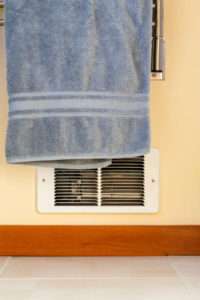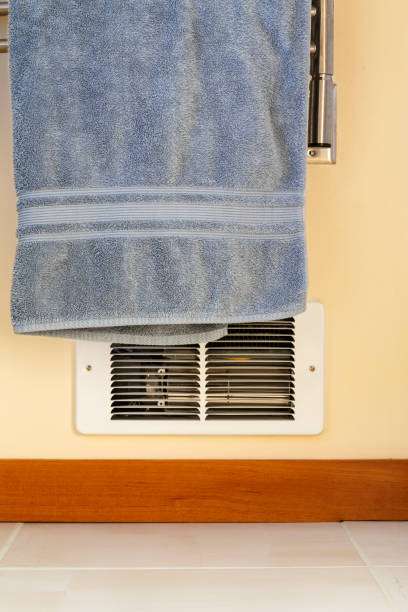This post may contain affiliate links which means I may receive a commission for purchases made through links.

With the rise of other forms of heating like underfloor heating, baseboard heaters are no longer the most popular way for space heating. However, they can still be functional and useful for some spaces if they’re properly maintained. In addition, like with any other heating solution, you need to consider the issue of safety when planning to install a baseboard heater. So, are there any baseboard heating dangers you should know about?
Well, read on as I help you determine whether baseboard heaters are safe and the safety precautions you should consider.
Parts of an electric baseboard heating system
In most cases, a basic baseboard heating system is made up of 2 components; the heating element and a thermostat. That way, instead of using a fan-assisted process to heat your home, electricity passes through the heating element, generating adequate heat to warm your home. More importantly, these components are usually installed against walls or in the room’s baseboard areas, hence the name baseboard heaters. In terms of dimension, electric baseboard heaters are about 2 -8 ft long and 8- 10 inches tall.
Moreover, baseboard heating is quite popular in most older homes, thanks to its ease of installation. Specifically, they don’t need any ductwork, making them some of the easiest heating systems to install.
Are electric baseboard heaters safe?
In general, baseboard heaters are considered safe and their fire danger is relatively low if they’re used and maintained properly. But if they’re used improperly, they can pose the risk of a fire hazard. For that reason, it’s important to understand the baseboard heating dangers that are linked to these fixed-position finned tube heating systems. In addition, you should consider a few safety precautions that will help to prevent a fire hazard, while maximizing your home’s heating potential.
Potential baseboard heating dangers
-
Fire hazards
Like any other heat source, electric baseboard heaters pose a fire risk, especially if they’re installed close to flammable objects. This usually happens when flammable toys and drapery find their way into the large gap at the top of your heating unit.
To prevent this, it’s important to ensure that your kids don’t leave their toys laying on the baseboard heaters. Take the necessary precautions to ensure that your kids don’t play near the baseboard heating units. Similarly, avoid laying an electrical cord or other objects like rugs and curtains near the baseboard heating unit. On top of that, make sure you hang cords from window blinds to prevent them from falling into these heating devices. Alternatively, you can install a baseboard heater over the heater to cover the open gap at the top. This will prevent objects from entering the heating system or touching the heating element. Also, you can consider installing hydronic baseboard heaters since they don’t pose the same fire risk as their electric counterparts.
-
Risk of injury
Both types of baseboard heaters (electric and hot water systems) usually have exposed unfinished sharp metal edges. In addition, their covers are made up of steel, which holds and dissipates heat energy to aid in the convection process. Unfortunately, this can lead to various problems.
First, the baseboard heater covers operate at temperatures of up to 200 deg F. So, when you or your kids get close to a functioning baseboard heating unit, they can quickly burn their skin. This poses a serious risk to kids that are just learning to stand or crawl since they use the heater to support themselves. To prevent this risk, constantly watch your kids to ensure that they don’t touch the baseboard heater covers.
Secondly, the exposed sharp edges on your baseboard heater can lead to severe injury. Be careful when handling your baseboard heater to prevent getting injured by those edges. If possible, use a one-piece panel design whose exposed ends are concealed by end caps.
-
Dry heat
As you know, baseboard heaters generate a very dry heat. This can lead to various problems like dry throats, bloody noses, dry eyes, and dry skin for people who use them. To avoid that, you should consider adding a humidifier to your heating system to add moisture to the air. On the downside, the humidifiers will require regular cleaning and increase your electricity costs.
Baseboard heating safety precautions
-
Thermostat control
To ensure the safe operation of your electric baseboard heaters, use only one thermostat to control different units. Although this may cause some units to go off or on at slightly different temperatures, controlling your heating system with a single thermostat will prevent your heaters from overheating. Moreover, this will ensure that the thermostat stays in a single setting, resulting in more efficient heating.
-
Safe Heater & Furniture placement
Putting objects and furniture too close to the baseboard heater creates a potential hazard if the items are made of flammable material. The same case applies to hanging curtains near or above the heater.
To prevent these problems, make sure you install your heating units at least 2 cm from the floor. Also, you should not install them below electrical outlets or close to the furniture. Instead, you should leave adequate space between the heater and the furniture. To be precise, chairs, couches and other furniture should be about 6” away from your electric baseboard heaters. This will help to avoid the fire risk and ensure the units heat your house effectively.
-
Avoid blocking the airflow
A baseboard heating unit draws cold air and warms it with the electrically heated elements. The heated air then rises to the top of the heater where it draws cooler air from the room and the cycle continues repeatedly.
However, for the heating unit to function properly, you should ensure that there is nothing blocking the airflow. This involves placing the furniture at least 6” from the heater or 12” from the door. In addition, heating units with fans require much more clearance of about 3 ft.
-
Install baseboard covers
Baseboard heat cover installation is one of the most effective ways of keeping your toddlers safe from baseboard heating. In addition, these covers keep small toys and little fingers away from the heating element, while maintaining your home’s aesthetics. Better yet, the best baseboard heating covers come with smooth end caps to eliminate sharp edges, preventing unnecessary injuries and bruises.
-
Keep your children away from electric baseboard heaters
If you’ve small children in your home, always supervise them when they are around these heaters. Their small toys and tiny fingers can easily find their way into the unit’s openings, leading to various safety and fire hazards. More notably, never allow children near the baseboard heaters since most units are usually hot to the touch, which can lead to serious burns.
-
Clean/ Vacuum the baseboard heater occasionally
Dust and other particles tend to accumulate in your baseboard heater over time, which can create a safety issue. For instance, the dirt and dust buildup can cause baseboard heater overheating or block the airflow. At the same time, this will increase the efficiency of your heater, increasing your energy bills.
Therefore, it’s important to clean or vacuum your electric baseboard heater at least every 3 to 6 months to remove the accumulated dust & debris. Moreover, vacuuming will help to get rid of the odor problem caused by ‘burnt dirt’.
-
Use baseboard heater protection switches
Most modern baseboard heater models are equipped with protection switches that turn off the unit if it overheats or reaches a dangerous heat level. Moreover, these auto safety features allow the unit to reactivate when the temperature gets back to normal. These safety features will provide an additional level of assurance when you’re considering the safety of your electric baseboard heaters.
Final word
Although they’re not as popular as they used to be, baseboard heaters are a relatively safe option for heating your home. However, there are some baseboard heating dangers you should be aware of like potential fire hazards and injuries. Luckily, you can avoid these challenges by considering safety tips like thermostat control, regular cleaning, and effective baseboard heating installation. All in all, baseboard heating is a safe, enjoyable, and effective space heating solution!
